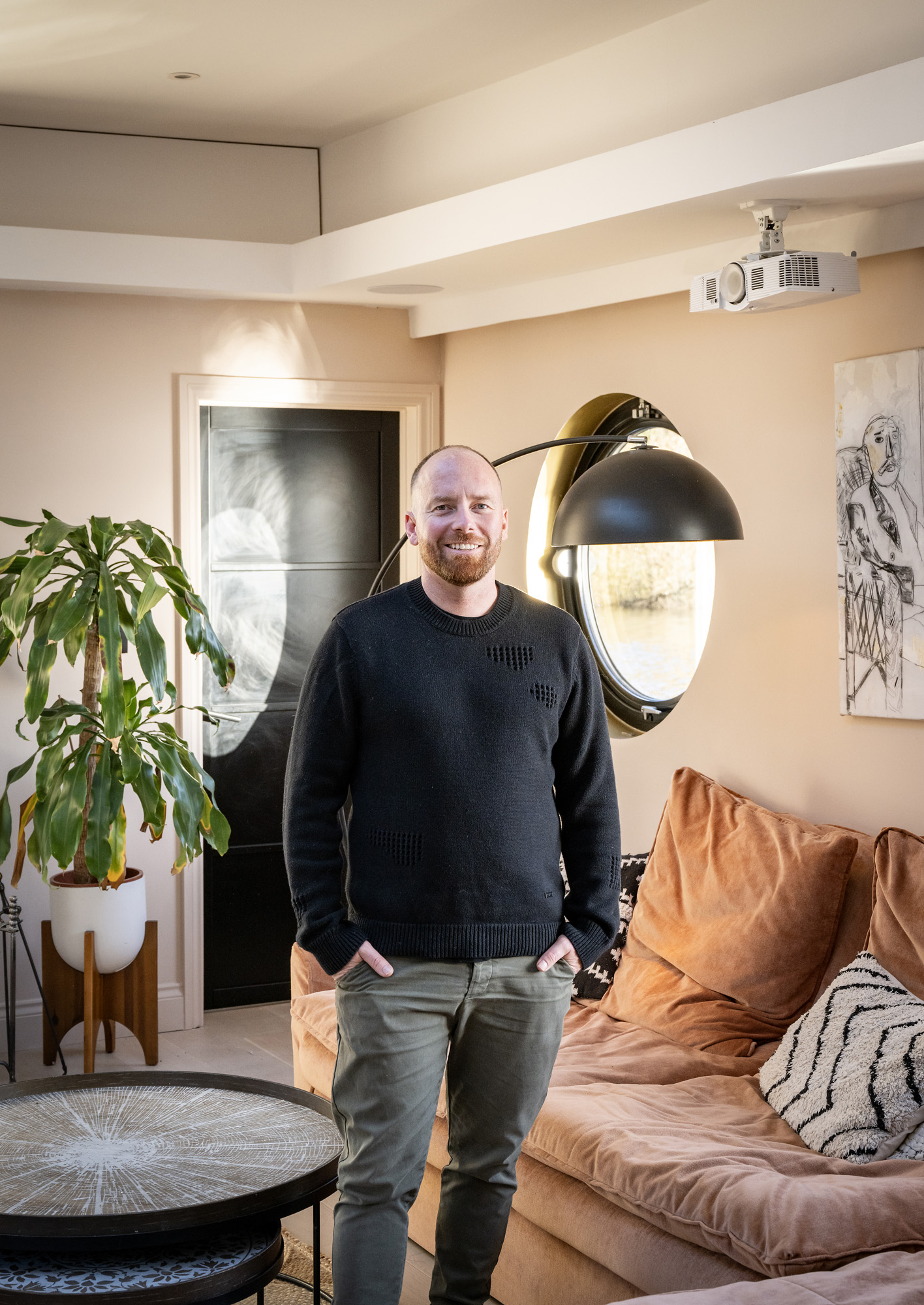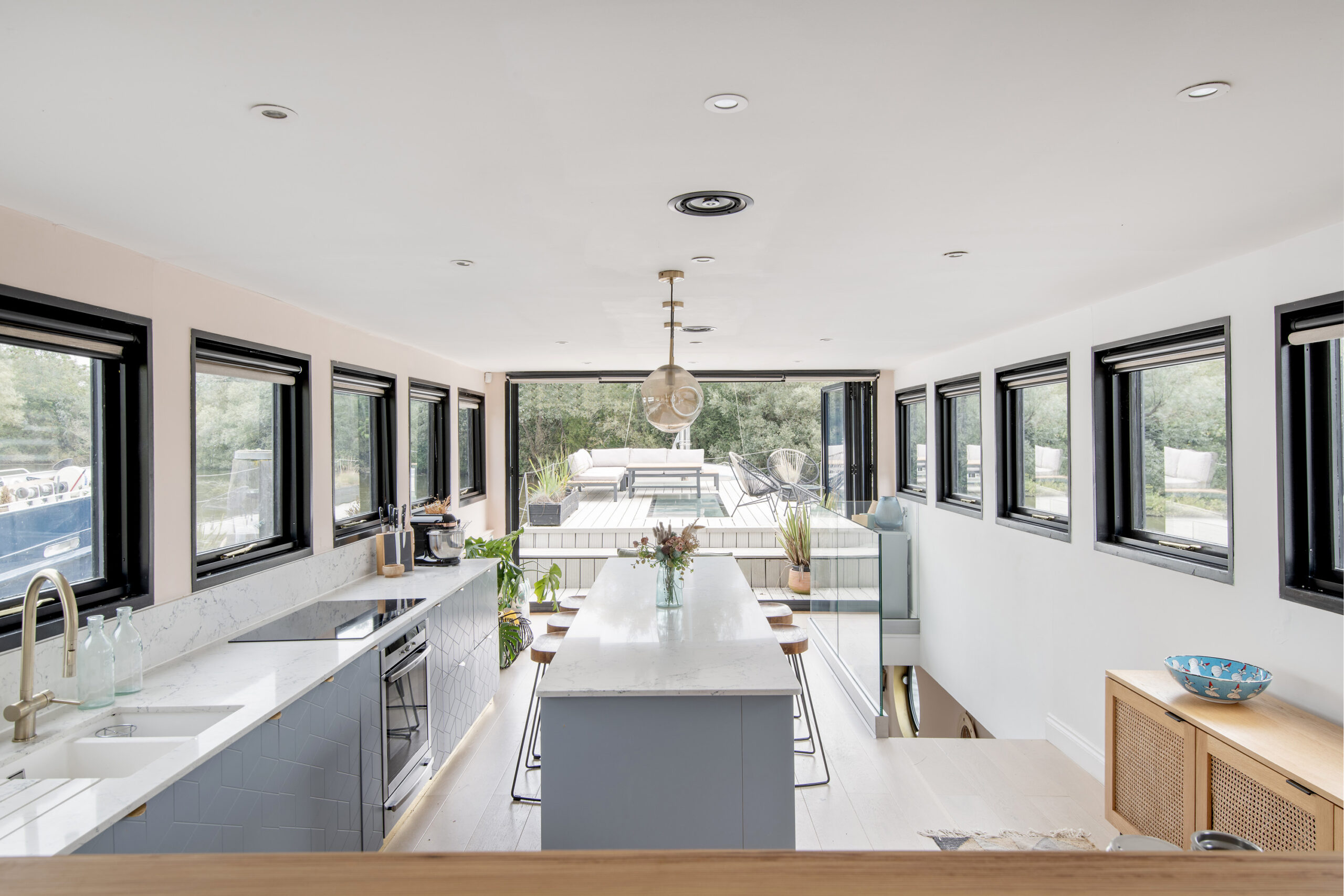Having converted a boat into a three-bedroom design-led home, owner Rohan Tully explains why living on the tidal Thames gives you a different viewpoint on life.
Set within a quiet neighbourhood in Surrey, this spacious two-storey home features quartz worktops, a Stovax wood burner and bi-folding glass doors. It also has a deck, a stern and a wheelhouse. This One Floats isn’t your average home. Formerly a Dutch barge, it’s now a houseboat that gives bricks-and-mortar homes a run for their money.
The vast vessel plays with expectations in every sense. “We wanted something conducive to not feeling like you’re on a boat,” owner Rohan Tully explains. A key aim of the 15-month conversion was maximising space. In the reception room, the high ceiling creates a sense of volume. Meanwhile, light floods in through an abundance of windows to further elevate the bright and airy aesthetic.
“The first step was finding it,” Rohan says of the ambitious project. Striking gold with a well-maintained barge that had been owned by the same family for many years, the “original layout and design was sketched out on the back of a napkin”, he recalls.



Too long for London’s waterways, a 10-metre section was removed from the middle – taking the barge to a still impressive 30 metres in length. “Sailing across the channel in December, before the renovation, was an adventure in itself,” Rohan recalls with a smile. “We got arrested in the middle of the journey and ordered back under blue lights with about five boats.” As a result, Rohan and the crew missed their weather window, leading to an even stormier crossing. “We’d done everything correctly, but something got lost in translation.”
Originally designed to carry heavy cargo, the next step was to ensure the boat didn’t sit so high in the water that it couldn’t clear low bridges. Now in River Medway, 40 tonnes of concrete were poured into the hull in the hope that it would dry before the tide went out. “That was a bit of a sleepless night, wondering if the floor would be sloping at a 45-degree angle,” Rohan recalls.

“There’s always an interesting conversation to be had on the pontoon. It’s a lifestyle choice that you won’t ever regret.”



Everything went to plan and a high-spec fit-out ensued. On the practical side, spray foam insulation, 16 layers of aluminium foil and underfloor heating were installed to keep the boat warm. “When you live on a boat, people always ask: ‘Is it cold? Is it dark? Is it small?’” Rohan muses. “We’ve addressed all those things.”
With finishing touches added in London, the renovation project was complete. The quality of craftsmanship is evident throughout. Finished in monochromatic Bert & May tiles, the kitchen is arranged around a central island illuminated by stylish pendant lights. This space is notably contemporary, with integrated appliances and glazing which folds to grant access to a raised terrace. The upstairs level is effectively an extension of the wheelhouse. Sticking to the original lines of the vessel, the sympathetic conversion doesn’t seem at all out of place.
Downstairs in the voluminous reception and dining room, engineered wood flooring grounds the space. On either side, oversized porthole windows gaze out across the water. “Windows are normally quite small on boats,” Rohan states. “But here, the outside becomes part of the inside space – like the light reflecting off the water onto the ceiling.”
“There are no planning constraints,” Rohan says of renovating a boat – something which has led to an imaginative conversion. The wood-wrapped principal bedroom suite comes with a Jacuzzi bath, for instance. However, there were still plenty of obstacles, the most challenging of which were logistical.
Getting materials on and off the boat caused the largest headaches. The reception room skylight – a three square metre piece of walk-on glass – weighs 300 kilos. With no crane, and while the boat was still in the sea, it took 10 people to bring it onboard.



Post-conversion, the problems of life on the water are ones that many city-dwellers would be glad of. “If you make the mistake of feeding the swans, they’ll come and tap on your window in the morning,” Rohan says. “We learnt that the hard way.” The instant connection with nature is unmistakable. There is even a particular seal Rohan often spots.
“There’s always an interesting conversation to be had on the pontoon,” he explains, gesturing out over Penton Hook Marina. “It has a real community feel and everyone’s always keen to help each other out. It’s a lifestyle choice that you won’t ever regret.”















